End points of stellar evolution
| Starting Mass | Outcome | Last Mass | Terminal Size | Density |
| > 20 MSun | Blackness Hole | whatever | two.95 (M/MSun) km | N/A |
| 8 < M < twenty MSun | Neutron star | < 3-4 MSun | 10 &minus 20 km ( &darr M ) | 1018 kg/chiliad3 |
| 0.4 < K < 8 MSun | White Dwarfs (Carbon) | < 1.4 MSun | 7000 km ( &darr M ) | 109 kg/miii |
| 0.08 < M < 0.4 MSun | White Dwarfs (Helium) | 0.08 < M < 0.4 ThouSun | 14000 km ( &darr Yard ) |
| Thousand < 0.08 MSun | Brown Dwarfs | M < 0.08 ChiliadSun | 10v km |
Nascence of a Neutron Star
- The death of a loftier-mass star (such as Betelgeuse) will leave behind a neutron star.
- Initially, the neutron star volition be very hot, most 10eleven One thousand.
- It will glow mainly in the X-ray part of the spectrum.
- Over its offset few hundred years of life, the neutron star's surface cools down to 106 G and continues to glow in the x-ray.
- Immature neutron stars are found in supernova remnants.
X-ray Prototype of the Puppis A Supernova Remnant - The small point-source is a neutron star.
- The neutron star is non at the centre since information technology was violently kicked by the supernova explosion.
- The neutron star moves with a velocity of g km/south.
| 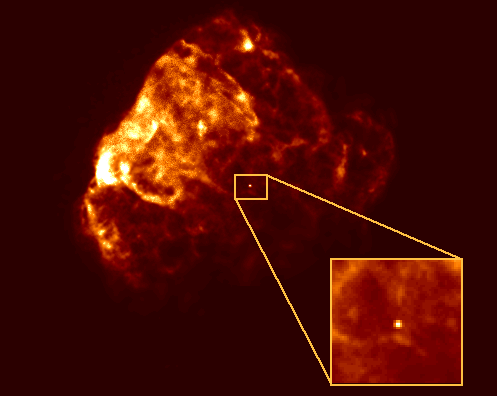 |
The Crab Nebula
- In the twelvemonth 1054 A.D. the Chinese Courtroom astronomer/astrologer Yang Wei-Te noticed a bright new star which suddenly appeared in the constellation Taurus.
- At its brightest (Supernovae explosion), information technology was almost as bright as Venus
- It was visible during the daytime for 23 days and then continued to exist visible to the naked centre at night for another 653 days.
- In the year 1731 John Bevis observed a "fuzzy" white nebula at the same location as the new star.
- Charles Messier observed the nebula in 1758. Messier was interested in finding comets and wanted to make a catalogue of "slow" non-comet fuzzy objects. This nebula became the start object in his catalogue, M1.
- The fuzzy nebula is called the Crab Nebula or M1 today.
Truthful Colour Photo of the Crab Nebula - Blood-red = Hydrogen Balmer transition respective to ionized hydrogen recombining with electrons.
- Blue = Synchrotron emission as electrons spiral effectually magnetic field lines.
- photo made past astrophotographer David Malin
- The total power output by the Crab Nebula is 105 LSun
- This is incredible, since it is most 1000 years later the supernova explosion.
- The neutron star inside this nebula rotates once every 33 ms (or about 30 times a second).
- Nosotros see a bright spot on the neutron star, so the star appears to flash once every rotation menses.
- Nosotros now say this neutron star is a pulsar .
| 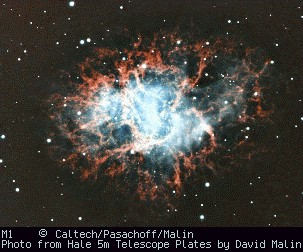 |
The Nearest Neutron Star - Nearest to Earth neutron star is in Corona Australis - 200 lite-years away.
- This is a more detailed photograph (in visible light) of RX J1856.5-3754 made with the ground-based telescope "Kueyen" in Chile.
- Kueyen is an 8 thou telescope which is office of 4 telescope assortment whose lite will be combined to make an equivalent sixteen m telescope.
- This picture shows a faint red deject around the neutron star.
- The red light is Hydrogen Balmer Blastoff emission.
- Photons emitted by the hot neutron star (T = 700,000 K) are exciting the Hydrogen surrounding the neutron star.
|
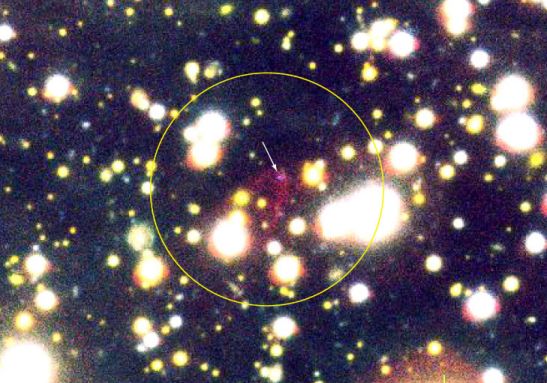 |
Structure of a Neutron Star - A neutron star balances gravity with neutron degeneracy pressure.
- The neutrons separated past a distance = d have a velocity given by the Heisenberg Uncertainty principle:
v = h/(ii &pi m d)
where m is the mass of the neutron and h is Planck'due south constant. - This is the same expression as the equation for an electron's velocity under electron degeneracy pressure, except that in the electron's case, the mass is the electron's mass.
- The neutron is about 2000 times more than massive than an electron, mn = 1800 thousandeast.
- In social club for the degenerate neutrons to have the same velocity as the degenerate electrons the neutrons must exist 1800 times closer to each other than the electrons in a white dwarf star.
- A neutron star with the aforementioned mass as a white dwarf has a radius about 1000 times smaller than a white dwarf.
- Typical radius for a neutron star is 10 km.
- Average density &rho of a 10 km star with a mass of 2 MSun is
&rho = 4 ten 1030 kg ten three/( 4 &pi x 1012 thousand3) = 1018 kg/m 3 - This is one billion times more dense than a white dwarf.
| 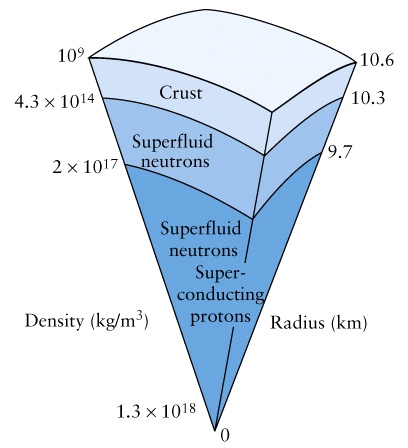 |
Uncertainty about a neutron star'southward structure
- It is not known what really lies at the core of a neutron star.
- Exotic particles such equally pions or unbound quarks might lie in the core.
- Each theory near the dense core provides a correction to neutron degeneracy pressure.
- Since the detailed nature of the cadre is unknown, the forces opposing gravity are not known exactly and the sizes of neutron stars are not known exactly.
- For instance, ii dissimilar, but reasonable theories of neutron stars predict two different sizes for a neutron star with 1.4 MSun. One prediction is for a radius of 10 km, the other predicts a radius of 20 km.
- If you lot could accurately mensurate the radius of a neutron star and measure its mass, you lot could dominion out certain theories describing dense nuclear matter.
- However, very difficult to measure out the radius of a star this tiny.
Maximum Mass of a Neutron Star
- White dwarfs tin can't have a mass larger than 1.four ThousandSun (the Chandrasekhar limit) since their electrons tin't motion faster than lite.
- Neutron stars have a similar blazon of limit.
- Each theory of nuclear thing predicts a different maximum mass for neutron stars.
- Maximum masses range from 1.five to 4 ThouSun.
- If you measure a neutron star's mass, you tin dominion out theories with predicted maxima below your measured mass.
- The maximum mass is of import for identifying black holes.
- A black hole in a binary star arrangement has properties very similar to a neutron star, so they are hard to place.
- Suppose that you lot detect a mysterious object which is probably either a neutron star or a black pigsty. If you measure out the mass and find out that information technology is above the maximum mass limit for neutron stars, and then it must be a black hole.
The Discovery of the Offset Neutron Star
- Neutron stars were first theoretically predicted by Walter Baade and Fritz Zwicky in the 1930'southward.
- The properties seemed so bizarre that nobody took the prediction very seriously.
- In 1967 Jocelyn Bell was doing observations using a new radio telescope for her Ph.D. thesis.
- She discovered a radio indicate at one particular location which pulsed on and off with a menstruation of one.337 s.
- She and her supervisor, Antony Hewish, get-go came to the decision that this was a bespeak from an alien civilisation and chosen the point LGM = Little Green Men
- Afterward finding a 2nd like object at another location they realised these must be existent astronomical bodies.
- They came to the conclusion that they must be pulsars.
- In 1974 Hewish was awarded the Nobel prize in physics for the discovery of pulsars.
- Now over 1000 neutron stars accept been discovered. Among them 200 very fast millisecond pulsars
- Pulses for some pulsars have been seen in gamma-rays, x-rays, visible light, infrared, and radio
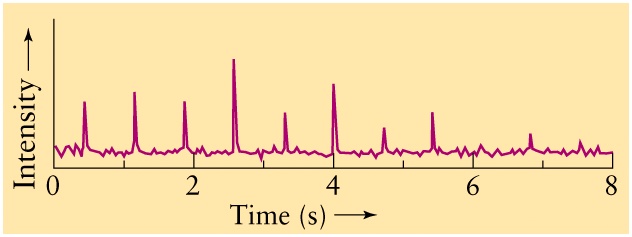
Maximum Spin Charge per unit of a Neutron Star
- A rotating object tin't spin as well fast, or it volition exist torn apart by the "centrifugal strength".
- The spin period = P is the time for a star to brand i rotation.
- Equate gravitational force at the surface and centrifugal force GM/R2 = &omega2 R
to notice the maximum possible athwart velocity &omega and, thus, the minimum possible period P=ii &pi/&omega - The minimum spin period for an object with mass K and radius R approximately:
Pmin = 2 &pi (R3/(GM))ane/ii = ( 3 &pi / (Thou &rho)) 1/2 - The minimum spin menstruum for some astronomical objects is:
| Object | Pmin | Actual spin period | Actual catamenia / Minimum menstruum |
| Earth | 5100 s = 1.iv hours | 1 24-hour interval | 17 x slower |
| Jupiter | 10,000 south = 2.viii hours | x hours | 4 10 slower |
| Sunday | x,000 s = two.8 hours | 25 days | 216 x slower |
| White Dwarf | about nine s | | |
| Neutron Star | 0.v ms | Fastest is 1.4 ms | iii ten slower |
- Neutron stars can spin very rapidly because they are tiny and very dense! One tin can immediately deduce that the density must exist high. Even if P=1 s, &rho > 3 &pi/(One thousand P2) = 1011 kg/m3. Could information technology be a white dwarf ? Perhaps, but Crab pulsar with 33 millisecond period can't be for sure !
- In 1982 the most rapidly rotating neutron star had P = ane.half dozen ms (Spin frequency = 600 Hz).
- In 2005 Jason Hessels (BSc. from U of A) discovered a neutron star with P = 1.4 ms (Spin frequency = 715 Hz).
Formation of a Rapidly Rotating, Magnetized Neutron Star
Same principles that nosotros considered during collapse of protostars
- A neutron star is formed from the collapse of a much larger star.
- Angular momentum is conserved during a collapse, and then the spin rate increases.
- Spin period is proportional to (radius)two
- For example: The Sun is about 5 orders of magnitude larger than a typical neutron star.
- If we collapse the Sun downwardly to the size of a neutron star, it will have a spin period 10-10 times smaller than the Sun.
- ie. it would spin with a period of 0.two ms
- Information technology is very easy to create a neutron star which spins with a period near a millisecond.
- Similarly, magnetic flux is conserved during a collapse so that the magnetic field force is proportional to 1/(radius)2
- If the Sun collapses down to the size of a neutron star, its magnetic field volition exist 10 billion times stronger.
- Typical magnetic fields on neutron stars are 1012 times stronger than the Dominicus's magnetic field.
- A minor number of neutron stars have magnetic fields 1014 times the Sun's magnetic field.
- These ultra-stiff magnetic field neutron stars are chosen magnetars.
- See Feb. 2003 Scientific American for a great commodity on magnetars
Even small initial rotation and magnetic field of neutron stars is highly amplified during the collapse
The Pulsar Mechanism
- The stiff magnetic field of a neutron star creates a magnetosphere effectually the neutron star.
- The magnetic poles are not usually aligned with the spin axis.
- Inside the neutron star, the electromagnetic forces rip off the electrons on the surface and the electrons get trapped by the magnetic field.
- The electrons become funnelled forth lines of force pointing out of the due north and south magnetic poles.
- The electrons are highly accelerated and they radiate synchrotron radiation which is beamed outwards in the directions of the poles.
- The spin of the star causes the beam of radiation to intersect our line of sight once a spin period.
- Nosotros see a pulse of low-cal which turns on and off with a regular period. (Light-house mechanism)
- Nosotros call this type of neutron star a pulsar.
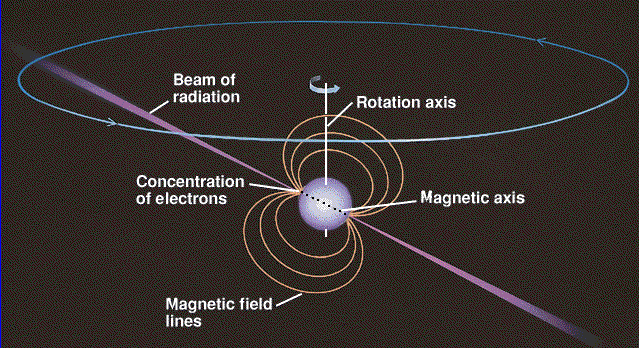
- A magnet which spins nearly an axis different from its symmetry axis emits radiation which causes it to lose energy.
- This loss of free energy causes the magnet'due south spin to slow down.
- The neutron star must wearisome down, which means that its spin period must increase slowly with fourth dimension.
Pulsar Recycling - Neutron stars are born chop-chop rotating only slow down due to the magnetic drain of their energy.
- This would propose that over fourth dimension all old pulsars should spin slowly.
- Notwithstanding, if a neutron star is in a binary system things alter.
- Matter tin flow from the companion to the neutron star through an accretion deejay.
- Equally matter from the deejay falls onto the neutron star, it adds mass and angular momentum (or spin) to the neutron star.
- This slowly causes the neutron star to spin faster.
- This process is called recycling.
- The accession disk is very hot and typically radiates x-rays.
- When Hydrogen and Helium are dumped onto the surface, small nuclear explosions occur causing bursts of 10-rays.
- When the explosion takes place on simply a small office of the star, we see the explosion only once every spin menstruum, so the burst seems to flicker.
- Flickering X-ray Bursting neutron stars have been observed which propose that they spin with periods in the range of three ms to ane.6 ms.
| 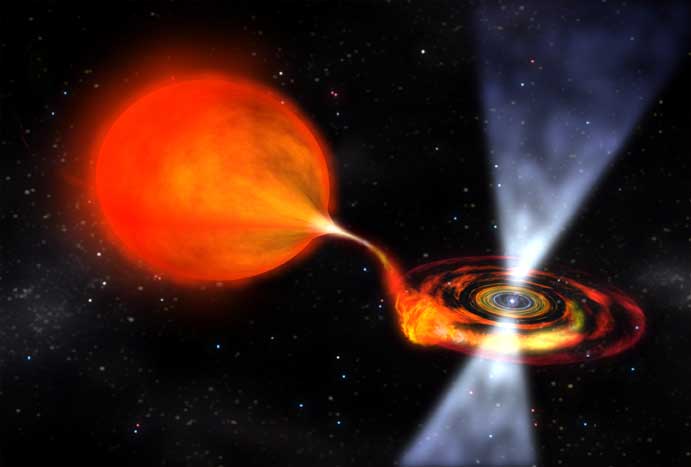 |
Lite Curve for an X-ray Burst - The large graph shows how effulgence varies with time during an X-ray Outburst.
- If the time centrality was expanded, y'all would be able to encounter a periodic wave with a frequency of 530Hz.
- The inset shows a "Fourier Spectrum" which shows the ascendant repetition frequency in the data.
| 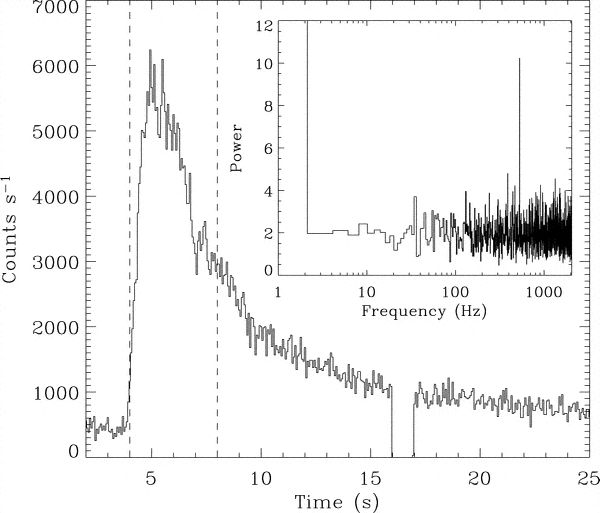 |
The Crab Nebula in Radio, Optical and X-rays - This shows a recent composite pic of the innermost region of the Crab Nebula (fabricated by combining images from the Chandra X-ray Telescope, Hubble Space telescope and NRAO radio telescopes).
- Blueish = 10-ray emission
- The Crab Pulsar is hidden in the heart of the rotating disk. The disk is caused by a current of air originating from the pulsar.
- The pulsar moves in the same management every bit its spin axis! Suggests that the supernova gave a peculiar type of "kicking" to the neutron star during its nascence.
| 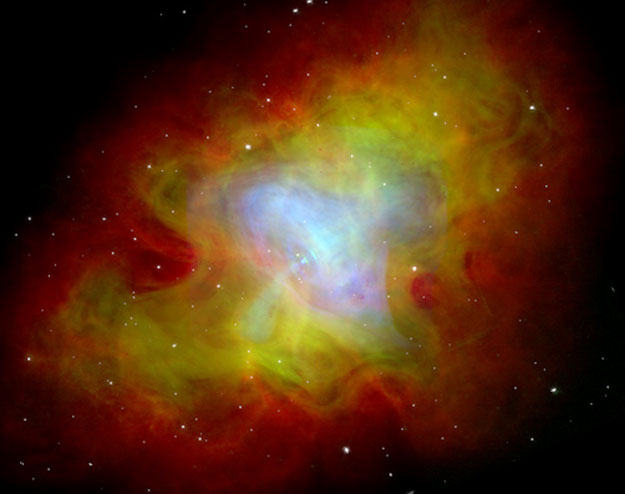 |
Adjacent lecture: Black Holes longoriahily1965.blogspot.com
Source: https://sites.ualberta.ca/~pogosyan/teaching/ASTRO_122/lect19/lecture19.html









0 Response to "what would happen if mass were continually added to a 2 msun neutron star?"
Post a Comment